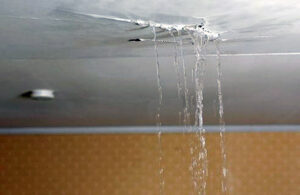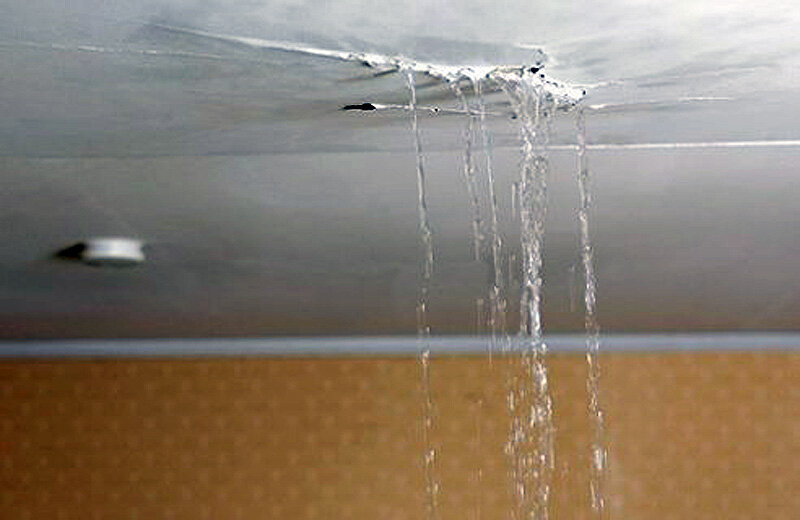
When dealing with leaks, it’s essential to understand the distinctions. While they may appear similar, roof and HVAC leaks are as different as a day and a malfunctioning umbrella.
What Is a roof leak?
Let’s start with the basics. A roof leak is akin to a guest crashing your indoor gathering. It involves water finding its way into your home through the roof, like nature playing a not-amusing prank.
What Is HVAC Leak?
On the other hand, an HVAC leak is comparable to an admirer who’s not so discreet. It occurs when your air conditioning or heating system shows affection by leaking refrigerant or water. It’s not the kind of embrace you’d welcome.
The Critical Difference Between A Roof Leak and an HVAC Leak: Location of the Roof and HVAC Leak
One noticeable contrast between roof leaks and HVAC leaks lies in their locations. Roof leaks typically originate above your head from the roof and seep through your ceiling. It’s like having a rain cloud indoors!
When it comes to leaks, HVAC issues tend to stick to the ground quietly, making their way around your heating or cooling setup. It’s like a leaky pipe deciding to join in on the fun!
Causes of the Leak
So why do these leaks happen? Roof leaks often stem from missing shingles, cracked flashing, or even mischievous tree branches getting too cozy with your roof. It’s as if your roof suddenly wanted to become a puzzle master! On the other hand, HVAC leaks can be due to worn-out seals, clogged drain lines, or an excess of condensation. It’s like your air conditioner showcasing its plumbing prowess!
Detecting Roof and HVAC Leaks
How can you spot these leaks? For roof issues, watch out for water stains, drooping ceilings, or even an unexpected indoor waterfall—those are indicators! It’s akin to being a detective but with
towels on hand! As for HVAC troubles, listen for hissing noises, inspect for ice buildup, or keep an eye out for puddles—those are hints that your HVAC system might be causing trouble!
Fixing and Maintaining Leaks
To start, let’s discuss how to address these leaks. Dealing with roof leaks often involves repairing shingles, sealing cracks, or seeking help from roof experts. It’s like giving your roof a superhero makeover! On the other hand, managing HVAC leaks may require tightening seals, clearing drain lines, or enlisting the help of HVAC professionals for some care and attention. It’s akin to treating your air conditioner to a spa day!
Impact of Roof Leaks on Indoor Air Quality
Now, let’s explore the realm! When rain infiltrates indoors due to a roof leak, it’s not about avoiding drips—it involves combating the effects on your air quality. Mold and mildew thrive in damp conditions, transforming your space into a damp environment. It’s like having a garden without the blooms!
Impact of HVAC Leaks on Indoor Air Quality
Moving on to HVAC leaks, imagine this scenario: your air conditioner decides to leak refrigerant or water. Suddenly, indoor air quality deteriorates as allergens and pollutants host a gathering. It’s like hosting guests at your meeting.
Health Dangers Linked to Different Types of Leaks
So, what kind of health risks are we looking at? When it comes to roof leaks, you’re up against a battle with mold spores and bacteria that can quickly trigger allergies and breathing problems before you know it. On the other hand, HVAC leaks may release substances into the air, causing headaches, dizziness, and some serious sneezing episodes. It’s like playing a game of chance with your well-being—not an experience.
Costs for Fixing Roof Leaks
Alright, let’s dive into the financials! Dealing with those roof leaks can sometimes feel like watching your bank account drain one drop at a time. Whether patching up shingles or sealing cracks, the repair expenses can pile up quicker than you can say “flush.” It’s akin to trying to stop a boat with a bucket.
Costs for Repairing HVAC Leaks
Let’s shift gears to HVAC leaks. Get ready for some costs—fixing these hidden leaks might seem like swapping your piggy bank for a coin fountain! Whether it’s tightening seals or clearing drain lines, the expenses can leave your wallet feeling lighter than a feather in a storm.
It feels as if you’re watching your earned money vanish before your eyes.
Comparing the Long-Term Financial Impact
So, what’s the final verdict? When it comes to lasting consequences, both roof leaks and HVAC leaks can strain your finances. Roof leaks may result in repair expenses, while HVAC leaks can lead to increased energy costs and expensive repairs over time. It’s like being stuck between a rock and a hard place—either way, your wallet takes a hit.
In Summary
There you have it—the rundown on roof leaks versus HVAC leaks. Whether it’s water seeping from above or below, understanding the distinction can help you avoid surprises. Remember, when faced with leaks in life, grab a wrench and tighten those screws.
FAQs
1. What does it mean when your HVAC system is leaking water?
A clogged condensate drain pipe is one of the most frequent reasons for water leaks from air conditioners. Over time, this pipe may clog with debris, dust, dirt, and algae. When this occurs, water leaks into your home when the line backs up and overflows from the drain pan.
2. Can HVAC cause a leak in the ceiling?
If your house has a split HVAC system, your air conditioning unit may be the source of a ceiling leak. Water vapor condenses in cooling systems, and this condensation may seep through the ceiling and into your attic.
3. How to tell the difference between condensation and roof leaks?
If your attic windows are installed, it should be pretty simple to distinguish between a roof leak and condensation. If condensation is the cause, you’ll typically notice some fog or water on the window glass. Windows don’t get wet from roof leaks unless the leak happens to be above the window.

